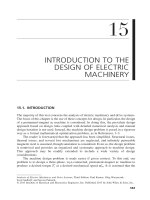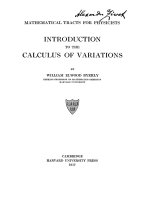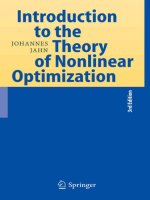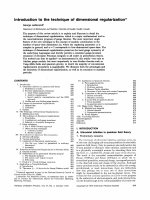introduction to the theory of nonlinear optimization
Bạn đang xem bản rút gọn của tài liệu. Xem và tải ngay bản đầy đủ của tài liệu tại đây (8.78 MB, 295 trang )
Introduction to the Theory
of Nonhnear Optimization
Johannes Jahn
Introduction
to the Theory
of NonHnear
Optimization
Third Edition
With
31
Figures
Sprin
g
er
Prof.
Dr. Johannes Jahn
Universitat Erlangen-Niirnberg
Institut fur Angewandte Mathematik
Martensstr. 3
91058 Erlangen
Germany
Library of Congress Control Number: 2006938674
ISBN 978-3-540-49378-5 Springer Berlin Heidelberg
New York
ISBN 978-3-540-61407-4 Second Edition Springer Berlin Heidelberg New York
This work is subject to copyright. All rights are reserved, whether the whole or part of the material is
concerned, specifically the rights of translation, reprinting, reuse of illustrations, recitation, broad-
casting, reproduction on microfilm or in any other way, and storage in data banks. Duplication of
this publication or parts thereof is permitted only under the provisions of the German Copyright
Law of September 9,1965, in its current version, and permission for use must always be obtained
from Springer. Violations are liable to prosecution under the German Copyright Law.
Springer is part of Springer Science+Business Media
springer.com
© Springer-Verlag Berlin Heidelberg 1994,1996,2007
The use of general descriptive names, registered names, trademarks, etc. in this publication does
not imply, even in the absence of
a
specific statement, that such names are exempt from the relevant
protective laws and regulations and therefore free for general use.
Production: LE-TgX Jelonek, Schmidt
&
Vockler GbR, Leipzig
Cover-design: Erich Kirchner, Heidelberg
SPIN 11932048 42/3100YL -543210 Printed on acid-free paper
To Claudia and Martin
Preface
This book presents
an
application-oriented introduction
to the
the-
ory
of
nonhnear optimization.
It
describes basic notions
and
concep-
tions
of
optimization
in the
setting
of
normed
or
even Banach spaces.
Various theorems
are
appHed
to
problems
in
related mathematical
areas.
For
instance,
the
Euler-Lagrange equation
in the
calculus
of
variations,
the
generahzed Kolmogorov condition
and the
alternation
theorem
in
approximation theory
as
well
as the
Pontryagin maximum
principle
in
optimal control theory
are
derived from general results
of
optimization.
Because
of
the introductory character
of
this text
it is not
intended
to give
a
complete description
of all
approaches
in
optimization.
For
instance, investigations
on
conjugate duality, sensitivity, stability,
re-
cession cones
and
other concepts
are not
included
in the
book.
The bibliography gives
a
survey
of
books
in the
area
of
nonlinear
optimization
and
related areas like approximation theory
and
optimal
control theory. Important papers
are
cited
as
footnotes
in the
text.
This third edition
is an
enlarged
and
revised version containing
an additional chapter
on
extended semidefinite optimization
and an
updated bibliography.
I
am
grateful
to S.
GeuB,
S.
Gmeiner,
S.
Keck,
Prof. Dr. E.W.
Sachs
and H.
Winkler
for
their support,
and I am
especially indebted
to
D.G.
Cunningham,
Dr. G.
Eichfelder,
Dr. F.
Hettlich,
Dr. J.
Klose,
Prof. Dr. E.W.
Sachs,
Dr. T.
Staib
and Dr. M.
Stingl
for
fruitful
discussions.
Erlangen, September 2006 Johannes Jahn
Contents
Preface vii
1 Introduction and Problem Formulation 1
2 Existence Theorems for Minimal Points 7
2.1 Problem Formulation 7
2.2 Existence Theorems 8
2.3 Set of Minimal Points 18
2.4 Application to Approximation Problems 19
2.5 Application to Optimal Control Problems 23
Exercises 29
3 Generalized Derivatives 31
3.1 Directional Derivative 31
3.2 Gateaux and Frechet Derivatives 37
3.3 Subdifferential 49
3.4 Quasidifferential 57
3.5 Clarke Derivative 67
Exercises 75
4 Tangent Cones 79
4.1 Definition and Properties 79
4.2 Optimality Conditions 88
4.3 A Lyusternik Theorem 95
Exercises 103
5 Generalized Lagrange Multiplier Rule 105
5.1 Problem Formulation 105
X Contents
5.2 Necessary Optimality Conditions 108
5.3 Sufficient Optimality Conditions 126
5.4 Application to Optimal Control Problems 136
Exercises 156
6 Duality 159
6.1 Problem Formulation 159
6.2 Duality Theorems 164
6.3 Saddle Point Theorems 168
6.4 Linear Problems 172
6.5 Application to Approximation Problems 175
Exercises 184
7 Application to Extended Semidefinite Optimization 187
7.1 Lowner Ordering Cone and Extensions 187
7.2 Optimality Conditions 202
7.3 Duality 207
Exercises 210
8 Direct Treatment of Special Optimization Problems 213
8.1 Linear Quadratic Optimal Control Problems 213
8.2 Time Minimal Control Problems 221
Exercises 238
A Weak Convergence 241
B Reflexivity of Banach Spaces 243
C Hahn-Banach Theorem 245
D Partially Ordered Linear Spaces 249
Bibliography 253
Answers to the Exercises 275
Index 289
Chapter 1
Introduction and Problem
Formulation
In optimization one investigates problems of the determination of a
minimal point of a functional on a nonempty subset of a real linear
space. To be more specific this means: Let X be a real linear space,
let S' be a nonempty subset of X, and let / : iS —> R be a given
functional. We ask for the minimal points of / on S. An element
X E S is called a minimal point offonS if
f{x) < f{x) for all xeS.
The set S is also called constraint set^ and the functional / is called
objective functional
In order to introduce optimization we present various typical op-
timization problems from Applied Mathematics. First we discuss a
design problem from structural engineering.
Example 1.1. As a simple example consider the design of a beam
with a rectangular cross-section and a given length I (see Fig. 1.1 and
1.2). The height xi and the width
X2
have to be determined.
The design variables Xi and
X2
have to be chosen in an area which
makes sense in practice. A certain stress condition must be satisfied,
i.e. the arising stresses cannot exceed a feasible stress. This leads to
the inequality
2000 < x\x2. (1.1)
Chapter 1. Introduction and Problem Formulation
"A
Xx
X2
Figure 1.1: Longitudinal section. Figure 1.2: Cross-section.
Moreover, a certain stability of the beam must be guaranteed. In
order to avoid a beam which is too slim we require
Xi < 4X2
(1.2)
and
X2 < Xi. (1.3)
Finally, the design variables should be nonnegative which means
and
xi > 0
X2>0.
(1.4)
(1.5)
Among all feasible values for xi and X2 we are interested in those
which lead to a light construction. Instead of the weight we can also
take the volume of the beam given as lxiX2 as a possible criterion
(where we assume that the material is homogeneous). Consequently,
we minimize lxiX2 subject to the constraints (1.1), ,(1.5).
With the next example we present a simple optimization problem
from the calculus of variations.
Example 1.2. In the calculus of variations one investigates, for
instance, problems of minimizing a functional / given as
f{x)= fl{x{t),x{t),t)dt
Chapter 1. Introduction and Problem Formulation 3
where —oo<a<6<oo and / is argumentwise continuous and
continuously differentiable with respect to x and x. A simple problem
of the calculus of variations is the following: Minimize / subject to
the class of curves from
S := {x e
C^[a^b]
\ x{a) = Xi and x{b)
—
X2}
where Xi and
X2
are fixed endpoints.
In control theory there are also many problems which can be for-
mulated as optimization problems. A simple problem of this type is
given in the following example.
Example 1.3. On the fixed time interval [0,1] we investigate
the linear system of differential equations
with the initial condition
^i(O) \ / -2x/2 \
0:2(0)
J { 5V2 J-
With the aid of an appropriate control function u G C[0,1] this dy-
namical system should be steered from the given initial state to a
terminal state in the set
M := {(xi,
X2)
eR'^\xl + xl = 1}.
In addition to this constraint a control function u minimizing the cost
functional
1
f{u)
= j{u{t)f
0
has to be determined.
Finally we discuss a simple problem from approximation theory.
Chapter 1. Introduction and Problem Formulation
(3
= sinh a
j3 = xa
X ^
1.600233
0 1 2 ^
Figure 1.3: Best approximation of sinh on
[0,2].
Example 1.4. We consider the problem of the determination of
a hnear function which approximates the hyperbohc sine function on
the interval [0,2] with respect to the maximum norm in a best way
(see Fig. 1.3). So, we minimize
max ax
aG[0,2]
sinh a I
This optimization problem can also be written as
min A
subject to the constraints
A
= max lax
—
sinh a\
aG[0,2]
(x,A) eR\
The preceding problem is equivalent to the following optimization
problem which has infinitely many constraints:
min A
subject to the constraints
ax
—
sinh a < A
ax
—
sinh a > —A
(x,A) GR^
for all a G
[0,
2]
Chapter 1. Introduction and Problem Formulation 5
In the following chapters the examples presented above will be
investigated again. The solvability of the design problem (in Exam-
ple 1.1) is discussed in Example 5.10 where the Karush-Kuhn-Tucker
conditions are used as necessary optimality conditions. Theorem 3.21
presents a necessary optimality condition known as Euler-Lagrange
equation for a minimal solution of the problem in Example 1.2. The
Pontryagin maximum principle is the essential tool for the solution of
the optimal control problem formulated in Example 1.3; an optimal
control is determined in the Examples 5.21 and 5.23. An application
of the alternation theorem leads to a solution of the linear Chebyshev
approximation problem (given in Example 1.4) which is obtained in
Example 6.17.
We complete this introduction with a short compendium of the
structure of this textbook. Of course, the question of the solvability
of a concrete nonlinear optimization problem is of primary interest
and, therefore, existence theorems are presented in Chapter 2. Sub-
sequently the question about characterizations of minimal points runs
like a red thread through this book. For the formulation of such char-
acterizations one has to approximate the objective functional (for that
reason we discuss various concepts of a derivative in Chapter 3) and
the constraint set (this is done with tangent cones in Chapter 4). Both
approximations combined result in the optimality conditions of Chap-
ter 5. The duality theory in Chapter 6 is closely related to optimality
conditions as well; minimal points are characterized by another opti-
mization problem being dual to the original problem. An apphcation
of optimality conditions and duahty theory to semidefinite optimiza-
tion being a topical field of research in optimization, is described in
Chapter 7. The results in the last chapter show that solutions or
characterizations of solutions of special optimization problems with
a rich mathematical structure can be derived sometimes in a direct
way.
It is interesting to note that the Hahn-Banach theorem (often in
the version of a separation theorem like the Eidelheit separation theo-
rem) proves itself to be the key for central characterization theorems.
Chapter 2
Existence Theorems for
Minimal Points
In this chapter we investigate a general optimization problem in a
real normed space. For such a problem we present assumptions under
which at least one minimal point exists. Moreover, we formulate
simple statements on the set of minimal points. Finally the existence
theorems obtained are applied to approximation and optimal control
problems.
2.1 Problem Formulation
The standard assumption of this chapter reads as follows:
Let (X,
II
• II) be a real normed space; "j
let 5 be a nonempty subset of X; > (2.1)
and let / : iS
—>
R be a given functional. J
Under this assumption we investigate the optimization problem
fin fix), (2.2)
i.e., we are looking for minimal points of / on S,
In general one does not know if the problem (2.2) makes sense
because / does not need to have a minimal point on S. For instance,
ioT X = S = R and f{x) = e^ the optimization problem (2.2) is not
8 Chapter 2. Existence Theorems for Minimal Points
solvable. In the next section we present conditions concerning / and
S which ensure the solvability of the problem (2.2).
2.2 Existence Theorems
A known existence theorem is the WeierstraB theorem which says that
every continuous function attains its minimum on a compact set. This
statement is modified in such a way that useful existence theorems
can be obtained for the general optimization problem (2.2).
Definition 2.1. Let the assumption (2.1) be satisfied. The func-
tional / is called weakly lower semicontinuous if for every sequence
(^n)nGN 1^ S couvcrgiug wcakly to some x G S' we have:
liminf/(a:^) > f{x)
n—^oo
(see Appendix A for the definition of the weak convergence).
Example 2.2. The functional / : R -^ R with
,. ._rOifx-0 1
^ ^ \ 1 otherwise J
is weakly lower semicontinuous (but not continuous at 0).
Now we present the announced modification of the WeierstraB
theorem.
Theorem 2.3. Let the assumption (2.1) he satisfied. If the set
S is weakly sequentially compact and the functional f is weakly lower
semicontinuous^ then there is at least one x E S with
f{x) < f{x) for all xeS,
i.e., the optimization problem (2.2) has at least one solution.
2.2.
Existence Theorems
Proof.
Let {xn)neN be a so-called infimal sequence in S', i.e., a
sequence with
limf{xn) = inf/(x).
n—>oo xES
Since the set S is weakly sequentially compact, there is a subsequence
(^nJiGN converging weakly to some x E S. Because of the weak lower
semicontinuity of / it follows
f{x) < liminf/(xnj = inf/(:^),
and the theorem is proved.
D
Now we proceed to specialize the statement of Theorem 2.3 in
order to get a version which is useful for apphcations. Using the
concept of the epigraph we characterize weakly lower semicontinuous
functionals.
Definition 2.4. Let the assumption (2.1) be satisfied. The set
E{f) := {{x,a) eSxR\ f{x) < a}
is called epigraph of the functional / (see Fig. 2.1).
a
/N
/
X
Figure 2.1: Epigraph of a functional.
10 Chapter 2. Existence Theorems for Minimal Points
Theorem 2.5. Let the assumption (2.1) he satisfied, and let the
set S he weakly sequentially
closed.
Then it follows:
f is weakly lower semicontinuous
<=^
E{f) is weakly sequentially closed
<==>
If for any a GR the set Sa '•= {x E S \ f{x) < a} is
nonempty, then Sa is weakly sequentially
closed.
Proof.
(a) Let / be weakly lower semicontinuous. If
{xn^Oin)neN
is any
sequence in E{f) with a weak limit (S, a) G X x R, then
{xn)neN
converges weakly to x and (ofn)nGN converges to a. Since S is
weakly sequentially closed, we obtain x E S. Next we choose
an arbitrary e > 0. Then there is a number no G N with
f{xn) < an <
o^
+ e for all natural numbers n>
UQ.
Since / is weakly lower semicontinuous, it follows
fix) < liminff{xn) < a + e.
n—»oo
This inequality holds for an arbitrary
5
> 0, and therefore we get
(S,
a) G E{f). Consequently the set E{f) is weakly sequentially
closed.
(b) Now we assume that E(f) is weakly sequentially closed, and we
fix an arbitrary a G M for which the level set Sa is nonempty.
Since the set S x {a} is weakly sequentially closed, the set
Sa X {a} = E{f) n{Sx {a})
is also weakly sequentially closed. But then the set Sa is weakly
sequentially closed as well.
(c) Finally we assume that the functional / is not weakly lower
semicontinuous. Then there is a sequence {xn)neN in S converg-
ing weakly to some x E S and for which
limmif{xn) < f{x).
2.2. Existence Theorems 11
If one chooses any a G M with
limiiii f{xn) < a < f{x),
n—^oo
then there is a subsequence (X^J^^N converging weakly to x ^ S
and for which
Xui e Sa for all I e N.
Because of /(x) > a the set S^ is not weakly sequentially closed.
D
Since not every continuous functional is weakly lower semicontin-
uous,
we turn our attention to a class of functionals for which every
continuous functional with a closed domain is weakly lower semicon-
tinuous.
Definition 2.6. Let 5 be a subset of a real linear space.
(a) The set S is called convex if for all x, y G 5
Xx + {1- X)y G S for all A G [0,1]
(see Fig. 2.2 and 2.3).
Figure 2.2: Convex set. Figure 2.3: Non-convex set.
(b) Let the set S be nonempty and convex. A functional f : S
•
is called convex if for all x, y G 5
f{Xx + (1 - X)y) < Xf{x) + (1 - A)/(y) for all
A
G [0,1]
(see Fig. 2.4 and 2.5).
12
Chapter 2. Existence Theorems for Minimal Points
-f- —
m
f(Xx+{l-X)y)
Xf{x) + (1 - X)f{y)
^
X
Ax + (1 - X)y
Figure 2.4: Convex functional.
(c) Let the set S be nonempty and convex. A functional / : iS
—>
1
is called concave if the functional —/ is convex (see Fig. 2.6).
Example 2.7.
(a) The empty set is always convex.
(b) The unit ball of a real normed space is a convex set.
(c) For X = 5 = R the function / with f{x) = x^ for all x G R is
convex.
(d) Every norm on a real linear space is a convex functional.
The convexity of a functional can also be characterized with the
aid of the epigraph.
Theorem 2.8. Let the assumption (2.1) he satisfied, and let the
set S he convex. Then it follows:
f is convex
<==^
E{f) is convex
=^ For every a &R the set Sa
'-=
{x E S \ f(x) < a} is
convex.
2.2.
Existence Theorems 13
/N
Figure
2.5:
Non-convex functional.
Figure
2.6:
Concave functional.
Proof.
(a)
If / is
convex, then
it
follows
for
arbitrary
(x, a),
(?/,/?)
G E{f)
and
an
arbitrary
AG [0,1]
fiXx+{l-X)y)
<
Xfix)
+
{1-X)f{y)
< Xa
+
{1-X)f3
resulting
in
X{x,a)
+ {l-X)iy,p)eE{f).
Consequently
the
epigraph
of / is
convex.
(b) Next
we
assume that
E{f) is
convex
and we
choose
any a
G M
for which
the set Sa is
nonempty
(the
case
S'Q,
= 0 is
trivial).
For
14 Chapter 2. Existence Theorems for Minimal Points
arbitrary x^y E Sa we have (x,a) G E{f) and (y^a) e £"(/),
and then we get for an arbitrary
A
G [0,1]
X{x,a) + {l-X){y,a)eE{f).
This means especially
f{Xx + (1 - X)y) <Xa + {l-X)a = a
and
Xx +
{l-X)yeSa-
Hence the set Sa is convex.
(c) Finally we assume that the epigraph E{f) is convex and we
show the convexity of /. For arbitrary x^y E S and an arbitrary
A G [0,1] it follows
X{xJ{x)) + {l-X){yJ{y))eE{f)
which implies
/(Ax +
(1
-
X)y)
< Xf{x) +
(1
- X)fiy).
Consequently the functional / is convex.
D
In general the convexity of the level sets Sa does not imply the
convexity of the functional /: this fact motivates the definition of the
concept of quasiconvexity.
Definition 2.9. Let the assumption (2.1) be satisfied, and let the
set S be convex. If for every a G
M
the set ^'a := {3; G 5 | f{x) < a}
is convex, then the functional / is called quasiconvex.
2.2.
Existence Theorems 15
Example 2.10.
(a) Every convex functional is also quasiconvex (see Thm. 2.8).
(b) For X = 5 = R the function / with f{x) = x^ for all x G M
is quasiconvex but it is not convex. The quasiconvexity results
from the convexity of the set
{x e S \ f{x) <a} = {xeR\x^<a}= (-oo,sgn{a){/\a\\
for every a G M.
Now we are able to give assumptions under which every continuous
functional is also weakly lower semicontinuous.
Lemma 2.11. Let the assumption (2.1) he satisfied, and let the
set S he convex and
closed.
If the functional f is continuous and
quasiconvex, then f is weakly lower semicontinuous.
Proof.
We choose an arbitrary a G R for which the set Sa '=
{x E S \ f{x) < a} is nonempty. Since / is continuous and S is
closed, the set Sa is also closed. Because of the quasiconvexity of /
the set Sa is convex and therefore it is also weakly sequentially closed
(see Appendix A). Then it follows from Theorem 2.5 that / is weakly
lower semicontinuous. •
Using this lemma we obtain the following existence theorem which
is useful for applications.
Theorem 2.12. Let S he a nonempty, convex, closed and houn-
ded suhset of a reflexive real Banach space, and let f : S -^ R he a
continuous quasiconvex functional. Then f has at least one minimal
point on S.
Proof.
With Theorem B.4 the set S is weakly sequentially com-
pact and with Lemma 2.11 / is weakly lower semicontinuous. Then
the assertion follows from Theorem 2.3. •
16 Chapter
2.
Existence Theorems
for
Minimal Points
At
the end of
this section
we
investigate
the
question under which
conditions
a
convex functional
is
also continuous. With
the
following
lemma which
may be
helpful
in
connection with
the
previous theorem
we show that every convex function which
is
defined
on an
open con-
vex
set and
continuous
at
some point
is
also continuous
on the
whole
set.
Lemma
2.13, Let the
assumption
(2.1)
he satisfied,
and let the
set
S
be open
and
convex.
If
the functional
f is
convex
and
continuous
at some
x ^ S,
then
f is
continuous
on S.
Proof.
We
show that
/ is
continuous
at any
point
of S. For
that
purpose
we
choose
an
arbitrary
x E S.
Since
/ is
continuous
at x and
S
is
open, there
is a
closed ball B{X^Q) around
x
with
the
radius
Q
so that
/ is
bounded from above
on B{x^
g)
by
some
a
G
R.
Because
S
is
convex
and
open there
is a A > 1 so
that
x + \{x
—
x) G S
and
the
closed ball B{x^{l
~ j)g)
around
x
with
the
radius
(1
—
^)^
is contained
in S.
Then
for
every
x G B{x,
(1
—
j)g)
there
is
some
y G
B{Ox,
g) (closed ball around Ox with
the
radius
g)
so that because
of
the
convexity
of /
fix)
= f{x +
{l-j)y)
= f(x-{l-j)x
+
{l-j)ix
+ y))
=
f{j{x +
X{x-x))
+
{l-j){x
+ y))
< jf{x + X{x-x)) + {l-j)f{x + y)
<
jf{x +
X(x-x))
+
{l-j)a
=:
p.
This means that
/ is
bounded from above
on B(x,
(1
—
j)g) by /3.
For
the
proof
of the
continuity
of / at £ we
take
any s
G (0,1). Then
we choose
an
arbitrary element
x of the
closed ball B{x,€{l
—
j)g)'
Because
of the
convexity
of / we get for
some
y
G 5(Ox, (1
—
j)g)
f{x)
= f{x +
ey)
2.2.
Existence Theorems
17
= f{{l-s)x
+ s{x + y))
< {l-e)f{x)+sf{x
+ y)
< {l-e)f{x)+€p
which imphes
f{x)-f{x)<e{P-m). (2.3)
Moreover we obtain
I
+
6
I +
S
^ {f{x)+eP)
l+€
which leads to
{l +
e)f{x)<f{x)+eP
and
-{f{x)-f{x))<e{p-f{x)). (2.4)
The inequahties (2.3) and (2.4) imply
\f{x)
-
f{x)\ < e{P
- fix))
for all
x
G B{x,e{l
- j)g).
So,
/
is continuous at x, and the proof is complete.
•
Under the assumptions of the proceding lemma it is shown in [68,
Prop.
2.2.6] that
/
is even Lipschitz continuous
at
every
x ^ S
(see
Definition 3.33).
18 Chapter 2. Existence Theorems for Minimal Points
2.3 Set of Minimal Points
After answering the question about the existence of a minimal solution
of an optimization problem, in this section the set of all minimal
points is investigated.
Theorem 2.14. Let S be a nonempty convex subset of a real
linear space. For every quasiconvex functional f : S -^ R the set of
minimal points of f on S is convex.
Proof.
If / has no minimal point on S, then the assertion is
evident. Therefore we assume that / has at least one minimal point
X on S. Since / is quasiconvex, the set
S:={xeS\ fix) < fix)}
is also convex. But this set equals the set of minimal points of / on
S. •
With the following definition we introduce the concept of a local
minimal point.
Definition 2.15. Let the assumption (2.1) be satisfied. An
element x E S is called a local minimal point oi f on S if there is a
ball B{x^ e) := {x E X \
\\x —
x\\ < e} around x with the radius
£:
> 0
so that
fix) < fix) for dllxeSn Bix, e).
The following theorem says that local minimal solutions of a con-
vex optimization problem are also (global) minimal solutions.
Theorem 2.16. Let S be a nonempty convex subset of a real
normed space. Every local minimal point of a convex functional f :
S —^^ is also a minimal point of f on S.
Proof.
Let x G 5 be a local minimal point of a convex functional
/ : S'
—>
M. Then there are an
£:
> 0 and a ball Bix.e) so that x is a









